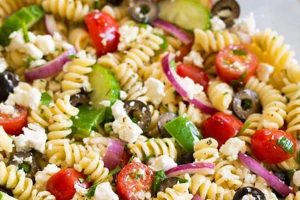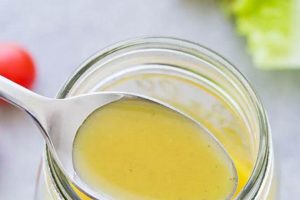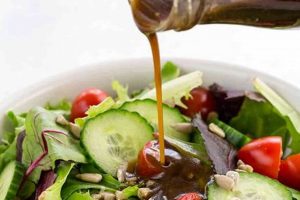Flavorful mixtures used to coat and enhance salads featuring ingredients common in Asian cuisines comprise a distinct culinary category. These mixtures often incorporate ingredients such as soy sauce, sesame oil, rice vinegar, ginger, garlic, and chili paste, resulting in a balance of sweet, sour, salty, and umami flavors. A classic example includes a blend of soy sauce, sesame oil, rice vinegar, and a touch of honey for sweetness.
The significance of these flavorful additions lies in their ability to elevate fresh vegetables and other components, creating a harmonious and complex flavor profile. Historically, the specific ingredients and ratios varied regionally, reflecting local tastes and available resources. The increasing globalization of cuisine has led to a broader understanding and appreciation of these diverse flavor combinations, allowing for greater creativity and adaptation in home kitchens and restaurants worldwide.
This exploration will delve into the various components, techniques, and regional variations found within this diverse culinary practice, offering a comprehensive understanding of its versatility and cultural significance. It will also examine how to create balanced flavor profiles, incorporate these mixtures into different salad styles, and adapt recipes to individual preferences and dietary needs.
Tips for Crafting Exceptional Salad Dressings Inspired by Asian Cuisine
Creating a balanced and flavorful dressing is crucial for enhancing the overall taste experience of any salad. The following tips offer guidance on achieving optimal results when preparing dressings inspired by the diverse flavors of Asia.
Tip 1: Balance is Key: Strive for a harmonious blend of sweet, sour, salty, and umami. Taste and adjust throughout the preparation process to achieve the desired flavor profile. A touch of sweetness can balance the acidity of vinegar, while a pinch of salt enhances the other flavors.
Tip 2: Fresh Ingredients Matter: Whenever possible, utilize freshly squeezed citrus juices, grated ginger, and minced garlic for the most vibrant and authentic flavors. These fresh ingredients provide a complexity that pre-packaged versions often lack.
Tip 3: Emulsification Enhances Texture: Proper emulsification creates a creamy, cohesive dressing that clings to salad ingredients. Whisking oil slowly into the other ingredients, or using a blender, helps achieve a stable emulsion.
Tip 4: Consider the Salad Components: The dressing should complement the other ingredients in the salad. A lighter dressing might be suitable for delicate greens, while a more robust dressing can stand up to heartier vegetables or protein additions.
Tip 5: Explore Regional Variations: Experiment with different ingredients and flavor combinations found in various Asian culinary traditions. Incorporating elements like fish sauce, gochujang, or black vinegar can add unique depth and complexity.
Tip 6: Mindful Oil Selection: The type of oil used impacts the dressing’s flavor and texture. Sesame oil adds a nutty richness, while a neutral oil like grapeseed or avocado oil allows other flavors to shine through.
Tip 7: Adjust to Personal Preference: Recipes serve as guidelines, not rigid rules. Feel free to adjust ingredient quantities to suit individual taste preferences and dietary needs.
By understanding the principles of balance, ingredient selection, and flavor pairings, one can create dressings that elevate salads from simple to extraordinary. These tips empower culinary exploration and creativity within the realm of Asian-inspired cuisine.
This exploration culminates with a deeper understanding of the art of creating exceptional dressings, enabling anyone to craft delicious and authentic flavor experiences.
1. Flavor Balance
Flavor balance represents a cornerstone of successful Asian-inspired salad dressings. These dressings typically feature a complex interplay of sweet, sour, salty, and umami tastes, carefully orchestrated to achieve a harmonious result. The interplay of these elements distinguishes these dressings from those of other culinary traditions, where a single flavor profile might dominate. For example, a dressing might balance the sweetness of rice vinegar with the saltiness of soy sauce, the sourness of lime juice, and the umami richness of fish sauce. Without this careful balancing act, the resulting flavor profile could be overly sweet, excessively acidic, or jarringly salty. The dynamic interplay creates a depth of flavor that complements the fresh ingredients in the salad.
A practical understanding of flavor balance allows for adaptation and creativity. A chef might choose to emphasize a particular flavor element based on the other components of the salad. For instance, a salad featuring grilled chicken might benefit from a dressing with a more pronounced umami component, while a salad with delicate greens might call for a lighter touch of acidity. Achieving balance is not about strict adherence to a specific formula, but rather about understanding the interplay of tastes and adjusting accordingly. This principle also enables adaptation to regional preferences and ingredient availability, allowing for a wide range of variations within the broader category of Asian-inspired salad dressings.
Mastery of flavor balance represents a crucial step toward crafting exceptional Asian-inspired salad dressings. It empowers culinary exploration by providing a framework for understanding the interplay of tastes. This understanding enables the creation of dressings that not only complement the salad ingredients but also offer a complex and satisfying culinary experience. Challenges can arise when attempting to balance unfamiliar ingredients or adapt to regional taste preferences, underscoring the importance of ongoing experimentation and refinement of technique.
2. Fresh Ingredients
The emphasis on fresh ingredients distinguishes Asian-inspired salad dressings. Freshly grated ginger offers a vibrant, pungent heat that powdered ginger cannot replicate. Similarly, freshly squeezed lime or lemon juice provides a bright, clean acidity that bottled counterparts often lack. The use of fresh herbs, such as cilantro, mint, or Thai basil, introduces nuanced aromatic complexities that dried herbs cannot achieve. These fresh components contribute not only to the overall flavor profile but also to the textural and visual appeal of the dressing. A dressing made with fresh ingredients possesses a vibrancy and depth of flavor that significantly elevates the sensory experience. For instance, a lemongrass-infused dressing gains a distinct citrusy aroma and flavor from freshly pounded lemongrass stalks, far surpassing the impact of using dried or processed versions.
Prioritizing fresh ingredients yields several benefits. Freshly minced garlic and chili peppers release more potent flavors and aromas compared to their pre-processed counterparts, contributing to a more dynamic sensory experience. The volatile compounds responsible for these distinct flavors and aromas degrade over time, making freshness paramount. Additionally, fresh ingredients often contain higher levels of vitamins and antioxidants, potentially contributing to the overall nutritional value of the salad. Selecting ingredients at their peak ripeness and using them promptly ensures optimal flavor and nutritional benefit. The practice of incorporating fresh ingredients aligns with culinary traditions that emphasize the connection between food and well-being. The crispness of fresh vegetables, the brightness of fresh herbs, and the pungency of freshly ground spices contribute to a more vibrant and satisfying culinary experience.
The reliance on fresh ingredients presents certain challenges. Sourcing high-quality, seasonal produce can require more effort and may involve higher costs. Proper storage and handling of fresh ingredients are essential to maintain quality and minimize waste. Despite these challenges, the resulting enhancement in flavor, aroma, and overall culinary experience underscores the importance of prioritizing fresh ingredients in Asian-inspired salad dressings. This commitment to freshness reinforces the connection between culinary practice and sensory enjoyment, highlighting the integral role of fresh ingredients in achieving truly authentic and delicious results.
3. Emulsification Technique
Emulsification plays a crucial role in the texture and flavor delivery of many Asian-inspired salad dressings. These dressings frequently combine oil and aqueous ingredients like vinegar, citrus juice, or soy sauce. Emulsification, the process of dispersing one liquid into another immiscible liquid, creates a stable mixture that prevents separation and enhances the dressing’s cling and mouthfeel. A properly emulsified dressing coats salad ingredients evenly, ensuring that each bite delivers a balanced flavor profile. Without emulsification, the oil and aqueous components would separate, resulting in an uneven distribution of flavor and a less desirable textural experience. A classic vinaigrette, for example, relies on emulsification to combine oil and vinegar, creating a homogenous mixture that clings to salad greens. In Asian-inspired dressings, this process is often facilitated by emulsifying agents like honey, mustard, or egg yolks, which help stabilize the mixture and prevent separation.
Several factors influence the success of emulsification in salad dressings. The ratio of oil to aqueous ingredients affects the stability of the emulsion. Vigorous whisking or blending creates the necessary shear force to disperse the oil droplets evenly within the aqueous phase. The viscosity of the ingredients also plays a role. A thicker aqueous phase, achieved through the addition of honey or a reduction in vinegar, can improve emulsion stability. Temperature also impacts the process; ingredients at similar temperatures emulsify more readily. A breakdown of the emulsion, resulting in separation, can occur due to excessive heat, freezing, or the addition of incompatible ingredients. Understanding these factors allows for greater control over the final texture and appearance of the dressing. For instance, a creamy peanut dressing benefits from a higher ratio of oil to vinegar, while a lighter vinaigrette might require a lower ratio.
Mastery of emulsification contributes significantly to the overall quality of an Asian-inspired salad dressing. A stable emulsion ensures even flavor distribution, enhances mouthfeel, and improves the visual appeal of the dressing. Challenges can arise when working with certain ingredients or temperature variations. However, understanding the underlying principles of emulsification, combined with practical experience, empowers one to create dressings with the desired texture and stability. This knowledge translates directly to the ability to consistently produce high-quality, flavorful, and visually appealing Asian-inspired salad dressings that enhance the overall dining experience.
4. Ingredient Pairings
Ingredient pairings constitute a defining characteristic of Asian-inspired salad dressings. Specific combinations contribute to the complex and balanced flavor profiles that distinguish these dressings. The interplay between ingredients extends beyond simply combining flavors; it involves understanding how different components interact to create synergistic effects. For example, the pungent heat of ginger often pairs well with the sweetness of honey or maple syrup, creating a balanced and nuanced flavor profile. Similarly, the savory depth of soy sauce complements the brightness of citrus fruits like lime or orange, resulting in a dressing that is both rich and refreshing. The selection of ingredients also considers textural contrasts. The crunch of toasted sesame seeds enhances the smooth, creamy texture of a tahini-based dressing, adding another layer of sensory complexity. Understanding these pairings allows for both authentic recreations of traditional recipes and creative exploration of new flavor combinations. Ignoring these established pairings can lead to unbalanced or disharmonious flavors, highlighting the importance of careful ingredient selection.
The principle of ingredient pairings extends to the broader context of the entire salad. A dressing featuring the umami richness of fish sauce might pair well with a salad containing grilled seafood or roasted vegetables, enhancing the savory notes of the dish. Conversely, a lighter, citrus-based dressing complements delicate greens and fresh herbs, creating a refreshing and vibrant salad. Consideration of these pairings allows the dressing to enhance and unify the overall flavor profile of the salad, rather than overpowering or clashing with the other components. Practical application of this knowledge enables the creation of cohesive and well-balanced salads that showcase the synergy between the dressing and the other ingredients. This understanding also allows for adaptation and customization, enabling the creation of dressings tailored to specific dietary needs or personal preferences.
Mastery of ingredient pairings in Asian-inspired salad dressings represents a significant step toward culinary expertise. It facilitates the creation of balanced, nuanced, and flavorful dressings that elevate the overall dining experience. Challenges can arise when working with unfamiliar ingredients or attempting to balance contrasting flavors. However, continued exploration and experimentation with different flavor combinations lead to a deeper understanding of these principles, ultimately empowering culinary creativity and innovation. This knowledge translates to the ability to craft not only authentic renditions of traditional recipes but also unique and personalized dressings that reflect individual tastes and preferences, expanding the possibilities within the realm of Asian-inspired cuisine.
5. Regional Variations
Regional variations play a significant role in the diversity of Asian-inspired salad dressings. Geographic location influences ingredient availability and culinary traditions, resulting in distinct flavor profiles and preparation techniques. Southeast Asian dressings, for example, often incorporate ingredients like fish sauce, lemongrass, and chilies, reflecting the region’s tropical climate and access to fresh seafood. In contrast, East Asian dressings might emphasize ingredients like soy sauce, sesame oil, and rice vinegar, showcasing the region’s agricultural staples. These regional nuances extend beyond core ingredients to encompass the balance of flavors. A Korean-style dressing might feature a pronounced spiciness from gochujang (fermented chili paste), while a Japanese-style dressing might prioritize a more subtle balance of umami and sweetness. Understanding these regional distinctions allows for a deeper appreciation of the complex culinary landscape of Asia and enables more informed recipe development. For instance, recognizing the role of black vinegar in Shanghainese cuisine allows one to create a dressing that authentically captures the region’s characteristic sweet and sour notes.
Examining regional variations provides insights into the historical and cultural context of Asian-inspired salad dressings. The use of specific ingredients often reflects local agricultural practices and trade routes. For instance, the prevalence of peanuts in Indonesian cuisine reflects the crop’s historical significance in the region. Culinary traditions, passed down through generations, also shape the flavor profiles and techniques associated with specific regions. A Vietnamese dressing might feature the refreshing herbaceousness of mint and cilantro, reflecting the country’s culinary emphasis on fresh herbs. These regional distinctions offer a glimpse into the diverse cultural influences that have shaped Asian cuisine over centuries. This understanding allows for a more nuanced approach to recipe adaptation and creation, enabling the development of dressings that not only taste delicious but also reflect the rich culinary heritage of specific regions. Adapting recipes without considering these regional nuances can lead to inauthentic and potentially unbalanced flavor profiles.
Appreciating regional variations represents a crucial element in understanding and creating authentic Asian-inspired salad dressings. This knowledge enables informed ingredient selection, accurate flavor balancing, and a deeper appreciation of the cultural context behind these culinary creations. While challenges exist in accessing certain regional ingredients or accurately replicating traditional techniques, the pursuit of regional authenticity enhances culinary exploration and fosters a greater understanding of the diverse culinary traditions within Asia. This awareness expands the possibilities for creative expression within the realm of Asian-inspired cuisine, allowing for both the preservation of traditional recipes and the development of innovative new flavor combinations.
6. Dietary Adaptations
Dietary adaptations represent a crucial consideration in the preparation of Asian-inspired salad dressings. Adapting recipes to accommodate specific dietary needs or preferences allows for greater inclusivity and ensures that individuals with varying dietary restrictions can enjoy these flavorful additions to their meals. This necessitates an understanding of common allergens and dietary restrictions, such as gluten intolerance, nut allergies, and veganism, as well as the ability to substitute ingredients without compromising flavor or texture.
- Gluten-Free Adaptations
Gluten, a protein found in wheat, barley, and rye, poses a challenge for individuals with celiac disease or gluten sensitivity. Traditional Asian recipes sometimes incorporate soy sauce, which often contains wheat. Gluten-free tamari or coconut aminos provide suitable alternatives, maintaining the savory umami notes without the gluten. Careful ingredient selection, including ensuring that other components like pre-made spice blends do not contain hidden gluten, is essential for creating truly gluten-free dressings.
- Nut-Free Adaptations
Nut allergies represent a serious concern for many individuals. Asian-inspired dressings frequently utilize nuts and nut-based oils, such as peanut oil or sesame oil. Substituting these ingredients with alternatives like grapeseed oil or sunflower oil allows for nut-free variations. Careful attention to cross-contamination during preparation is also crucial, especially in environments where nuts are present. Clearly labeling nut-free dressings prevents accidental exposure and ensures the safety of those with allergies.
- Vegan Adaptations
Vegan diets exclude all animal products, including honey and fish sauce, which are common ingredients in some Asian-inspired dressings. Maple syrup or agave nectar offer plant-based alternatives to honey, providing the necessary sweetness. Nutritional yeast or seaweed flakes can contribute umami notes in place of fish sauce. Understanding the functional role of each ingredient enables effective substitution without compromising the overall flavor profile. This allows for the creation of delicious and authentic vegan versions of traditional dressings.
- Low-Sodium Adaptations
Sodium intake represents a health concern for some individuals. Soy sauce, a staple in many Asian dressings, contributes significantly to sodium content. Low-sodium soy sauce or coconut aminos offer reduced-sodium alternatives. Balancing flavors through the use of fresh herbs, citrus juices, and spices can compensate for the reduced saltiness, ensuring a flavorful yet healthier dressing. Careful monitoring of sodium levels in all ingredients allows for the creation of dressings suitable for those following low-sodium diets.
These dietary adaptations demonstrate the versatility of Asian-inspired salad dressings. By understanding the underlying principles of flavor balance and ingredient functionality, recipes can be modified to accommodate diverse dietary needs without sacrificing flavor or authenticity. This inclusivity broadens culinary accessibility and allows individuals with varying dietary restrictions to enjoy the complex and vibrant flavors of Asian cuisine.
7. Creative Experimentation
Creative experimentation represents a driving force in the evolution of Asian-inspired salad dressings. It allows for the discovery of novel flavor combinations, the adaptation of traditional recipes to contemporary tastes, and the incorporation of new ingredients and techniques. This experimentation fosters innovation within the culinary landscape, pushing the boundaries of flavor profiles and expanding the possibilities within this specific culinary domain. For example, incorporating ingredients not traditionally associated with Asian cuisine, such as roasted beets or crumbled goat cheese, can introduce unexpected yet complementary flavors and textures. Similarly, experimenting with different types of vinegar, such as black vinegar or champagne vinegar, can subtly alter the flavor profile of a dressing, adding depth and complexity. This willingness to deviate from established norms allows for the creation of unique and personalized dressings that reflect individual creativity and culinary preferences. Conversely, a lack of experimentation can lead to stagnation, limiting the potential for new discoveries and hindering the evolution of culinary traditions.
The practical significance of creative experimentation lies in its ability to personalize and enhance the dining experience. Adapting traditional recipes to accommodate dietary restrictions, such as substituting honey with maple syrup for a vegan option, demonstrates the practical application of creative problem-solving within this culinary context. Furthermore, experimentation enables chefs and home cooks to tailor dressings to specific preferences, such as adjusting the level of spiciness or sweetness to suit individual palates. Developing new flavor combinations, such as pairing yuzu juice with toasted sesame oil, can elevate a simple salad to a culinary masterpiece. This creative exploration not only enhances the enjoyment of food but also fosters a deeper understanding of flavor profiles and ingredient interactions. Through experimentation, individuals develop a more nuanced appreciation for the art of culinary creation, transforming a simple salad dressing into a canvas for self-expression.
Creative experimentation remains essential for the continued evolution and diversification of Asian-inspired salad dressings. It allows for the fusion of tradition and innovation, resulting in a dynamic and ever-evolving culinary landscape. While challenges exist in balancing creativity with authenticity and ensuring that experimentation does not compromise the fundamental principles of flavor balance, the potential rewards far outweigh the risks. Embracing experimentation fosters culinary discovery, personalizes the dining experience, and ensures the continued vibrancy and relevance of Asian-inspired cuisine in a constantly evolving culinary world.
Frequently Asked Questions
The following addresses common inquiries regarding the preparation and utilization of dressings suitable for salads featuring ingredients commonly found in Asian cuisine.
Question 1: What distinguishes dressings suitable for Asian-inspired salads from other types of salad dressings?
Dressings suitable for Asian-inspired salads typically emphasize a balance of sweet, sour, salty, and umami flavors, often incorporating ingredients such as soy sauce, sesame oil, rice vinegar, ginger, and garlic. This flavor profile distinguishes them from dressings common in other culinary traditions, such as creamy ranch dressings or vinaigrette-style dressings.
Question 2: How can one achieve a balanced flavor profile when preparing these dressings?
Achieving balance involves careful consideration of the interplay between sweet, sour, salty, and umami elements. Tasting and adjusting throughout the preparation process allows for fine-tuning and ensures a harmonious final product. Utilizing fresh, high-quality ingredients also contributes significantly to the overall balance and complexity of the dressing.
Question 3: What are some common substitutions for individuals with dietary restrictions?
Common substitutions include gluten-free tamari or coconut aminos in place of soy sauce for those with gluten sensitivities, maple syrup or agave nectar as alternatives to honey for vegans, and grapeseed or sunflower oil as substitutes for nut-based oils for those with nut allergies. Careful consideration should be given to the overall flavor profile when making substitutions.
Question 4: What role does emulsification play in the preparation of these dressings?
Emulsification, the process of combining oil and aqueous ingredients into a stable mixture, is crucial for achieving the desired texture and consistency in many Asian-inspired dressings. It prevents separation and ensures a smooth, creamy texture that clings evenly to salad ingredients. Proper emulsification enhances both the visual appeal and the flavor delivery of the dressing.
Question 5: How can one adapt these dressings to complement different types of salads?
Adapting dressings involves considering the other ingredients in the salad. A lighter dressing might complement delicate greens, while a more robust dressing might pair well with heartier vegetables or protein additions. Adjusting the intensity of flavors, such as the level of spiciness or sweetness, can further enhance the pairing between the dressing and the salad components.
Question 6: How should one store homemade Asian-inspired salad dressings?
Homemade dressings should be stored in airtight containers in the refrigerator. Most dressings will keep for up to a week when properly refrigerated. Always check for signs of spoilage before consuming. Emulsified dressings may separate upon refrigeration; a gentle whisk or shake typically restores the desired consistency.
Understanding these fundamental aspects empowers individuals to confidently create and utilize a wide array of Asian-inspired salad dressings.
The following section explores specific recipes and techniques for preparing a variety of delicious and authentic Asian-inspired salad dressings.
Conclusion
Exploration of the nuances within the realm of mixtures designed to enhance salads featuring ingredients common in Asian cuisines reveals a complex interplay of flavor profiles, culinary techniques, and cultural influences. Balance among sweet, sour, salty, and umami elements remains paramount. Freshness of ingredients contributes significantly to vibrancy and depth of flavor. Emulsification techniques affect texture and stability. Careful consideration of ingredient pairings and regional variations ensures authenticity and complexity. Dietary adaptations expand inclusivity. Creative experimentation fosters innovation and personalization.
Culinary exploration within this domain offers a pathway not only to enhanced gastronomic experiences but also to a deeper appreciation of the rich and diverse culinary traditions of Asia. Continued exploration and refinement of technique promise further evolution and innovation within this vibrant area of culinary practice.






